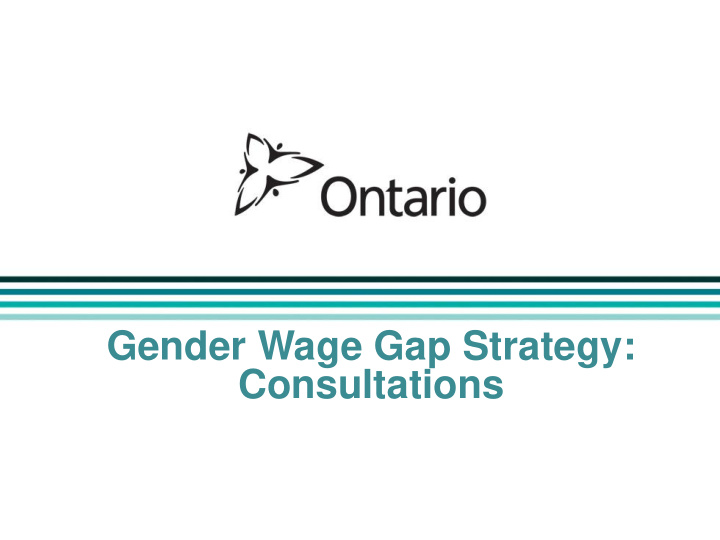



Gender Wage Gap Strategy: Consultations
Welcome and Introductions T he Minister of Labour’s mandate letter: • “Women make up an integral part of our economy and society, but on average still do not earn as much as men. You will work with the Minister Responsible for Women’s Issues and other ministers to develop a wage gap strategy that will close the gap between men and women in the context of the 21st century economy .” 2
Gender Wage Gap Strategy Steering Committee’s Mandate Identify the factors that cause the gender wage gap • Assess the impact of government actions, business • practices, social norms, and other factors on the gap Assess initiatives in other jurisdictions that might be • used in Ontario Create recommendations on a strategy to close the • gender wage gap Identify actions that can be taken by government, • business, labour, other organizations and individual leaders to close the gap 3
Snapshot of Ontario 2014 Labour Force Survey Estimates 11.27 million Ontarians aged 15 years and over 51.3% 48.7% male female 70.3% in 29.7% not 61.6% in 38.4% not the labour in the labour the labour in the labour force force force force • Males have an unemployment rate of 7.5% • Females have an unemployment rate of 7.1% 4
What is gender wage gap? The gender wage gap (GWG) represents the difference between the • earnings of men and women. The gap is more pronounced for Aboriginal and racialized women • and those with disabilities. Average hourly wages Average annual earnings, Average annual earnings, full-year full-time workers all earners 12% 26% 31.5% *2011, Statistics Canada 5
Ontario’s gender wage gap trends 100 90 Average Annual 80 Earnings, all earners 70 55.6% 60 Gender Wage Average 50 Gap % 43% Annual 38% 40 Earnings, full- 31.5% 29.7% year full-time 30 26% workers 18% 20 12% 11.9% Average 10 Hourly Wages 0 1976 1978 1980 1982 1984 1986 1988 1990 1992 1994 1996 1998 2000 2002 2004 2006 2008 2010 2012 2014 Year *Statistics Canada. Table 201-0102 and Table 282-0070, CANSIM (database). 6
Changes to the gap when other forms of discrimination are added (called “intersectionality”) Racialized females • • • Aboriginal females Females with a earn 19% less earn 18% less than disability earn 19% than racialized Aboriginal males. less than males males. with a disability. • This gap grows to This gap grows to 36% when • This gap grows to • 34% when Aboriginal females' 25% when the racialized females’ wages are wages of females wages are compared to the with a disability are compared to non- broader male compared to men racialized males. population. without a disability. * 2011 National Household Survey, average employment income (for racialized and Aboriginal data) and 2006 Survey of Labour Income and Dynamics, average hourly wages (for disability status). 7
Rationale Achieving greater workplace equality would benefit Ontario’s economy and society at large. It would: • Increase economic security for women and their families • Improve the province’s economic outcomes • Maximize labour force talent pool which benefits businesses Failure to address this gap could undermine the competitiveness of Ontario businesses and the province’s productivity. 8
Commonly Identified Factors Gender roles, traditions and stereotypes, bias and social norms are reflected through all these: Discrimination • Occupational Segregation • Caregiving Activities • Workplace Culture and Practices • Education • 9
Work – Life Cycle Entry into Re-entry Mid-career Workforce into Career Role Being a • Caregiving • Career Heading to • Workplace Modelling activities Retiree choices Retirement culture • Availability of /availability • Mentoring: • Workplace • Available • Credentialism leaves • Retirement pre-teen, practices income • Tax & benefit • Unionization planning teen, young • Workplace • Life policies • Benefits adult • Salary assistance expectancy • Workplace • Education: • Tax & benefit negotiation • Preparation • Caregiving culture level, • Caregiving policies for leadership activities • Workplace opportunities • Caregiving activities • Caregiving • Tax & benefit • Societal practices • Availability of activities activities policies • Preparation pressures leaves • Tax & benefit for leadership • Tax & benefit policies policies 10
Consultation Goals Encourage discussion of the gender wage gap by men and women • To consider the many issues affecting women and men in the 21 st century • economy Learn the impact of the gender wage gap in communities across Ontario • Share information on how the gap may affect local communities, labour • markets and economic development, and how it can be closed Gather personal stories, community and regional best practices on creating • equitable workplaces Learn from experts about related issues, research and analytic approaches • 11
GWG Strategy Consultation Process INFORMATION 13 PUBLIC SHARING WITH TOWNHALLS MINISTRIES CONSULTATION AND ENGAGEMENT STAKEHOLDER DIAGLOGUES CONSULTATION AND PAPERS 1:1 MEETINGS 12
THANK YOU E-Mail: genderwagegap@ontario.ca www.ontario.ca/genderwagegap | www.ontario.ca/equitesalariale #wagegapON 13
Recommend
More recommend